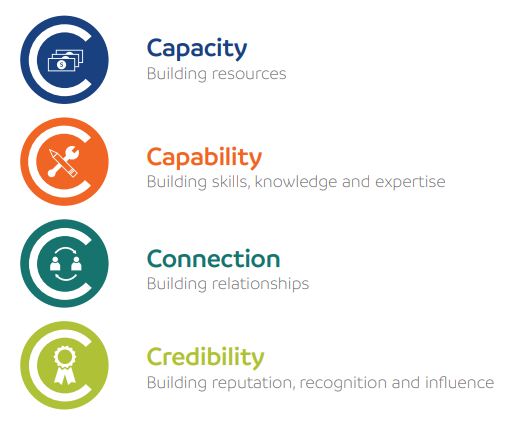Winter Meeting for National Associations 2022 – Building Resilience, Thriving in Uncertainty
The Role of Infrastructure Organisations
‘There is always light. Only if we are brave enough to see it. There is always light. Only if we are brave enough to be it.’ Delphine Moralis, incoming CEO of Philea, opened with this quote from Amanda Gorman, which summarises brilliantly this year’s Winter Meeting focusing on the role of philanthropy infrastructure organisations in building resilience and thriving in uncertainty. Carola Carazzone, incoming Vice-President of Philea and Max von Abendroth, incoming Chief Strategy Officer of Philea, have welcomed the members to the first joint Philea meeting of the year.
Lightning talks: Sharing learnings across Europe
The Winter Meeting provides national associations with a valuable opportunity to connect, share experiences and learn from each other’s work. The gathering started with a round of five ‘lightning talks’ followed by breakout discussions on a range of topics:
- ‘Advocating together: How collaboration strives at improving legal and fiscal frameworks’.
- ‘Developing a culture of giving: The Alliance of Responsible Public Benefit Collections Organisers’;
- ‘Designing and implementing public-private partnerships: The Italian Educational Poverty Fund’;
- ‘Education as a vehicle to bring together foundations and relevant stakeholders’
- ‘Purpose-driven transformation in corporate and philanthropic sectors’;
The breakout room focusing on Advocacy discussed the issues initially presented by Ruth Williams, from the Austrian Foundations Association. The Austrian legal context is fairly unique as law foresees only limited tax incentives for donations by public-benefit foundations. Ruth shared how multi-stakeholder cooperation between foundations, wider civil society, educators and more has enabled the creation of a more favourable legal framework for those wanting to be involved in education. This advocacy work was strengthened by a data-driven approach, for example using evidence from Germany to highlight the potential cost for the government in comparison to the amount of money that could be mobilised, the involvement of a diverse coalition of actors and the concrete solutions they brought to the table.
The second breakout group discussed Culture of Giving. This exchange was predominantly focused on Central and Eastern European countries, where the culture of giving is underdeveloped and there is a shared potential to increase individual giving. Klára Šplíchalová presented the Czech Donors Forum’s involvement in the Alliance of Responsible Public Benefit Collections Organisers – an informal initiative, which promotes high standards for giving. This Alliance was set up in the aftermath of increasing ad-hoc giving due to the COVID pandemic, which was presented as a reputational risk to the philanthropic sector. By regulating public collection as well as engaging educating civil society and the general public, this initiative aims at building trust and encouraging citizens to give more generously.
The third breakout group focused on Education with input from both Giorgio Righetti representing ACRI (Italy) and Alina Shenfeldt from the Russian Donors Forum. The ‘Italian Educational Poverty Fund’ started by ACRI in 2016 is an impressive example of public-private partnership and has allowed philanthropy to have a significant impact on the lives of children living in economic and educational poverty. In Russia, education has a considerable potential for collaboration beyond the philanthropic sector as foundations are increasingly concerned with tackling complex and systemic issues. Participants in this breakout room discussed the importance of a holistic and community approach for education and the need for digital innovation.
The last group focused on ‘Purpose-driven Transformation’ in both the corporate and philanthropic sectors presented by TUSEV’s Rana Kotan. As consumers are increasingly looking at what companies do, say and stand for, companies are turning towards purpose-driven transformation as part of their fight for competitive advantages in a changed environment. Businesses who seek to be positive social actors could provide a huge opportunity for the third sector. However, it is no longer enough for philanthropy to only give back, there is now a demand for more systemic interventions. This group discussed how corporations can engage with social problems and how, through collaboration and a clear purpose, this can become an opportunity for philanthropy.
Data: how national associations can assess and drive impact
These insightful discussions were followed by an ignite speech given by Daniel Knapp, Chief Economist at IAB Europe, the European-level association for the digital marketing and advertising ecosystem. Daniel presented how data can be an innovation barrier but, when mastered, it can also be used to accelerate our work and make it more efficient. Data allows us to understand how trends and conversations interlink and, crucially, help us to communicate – with our members, policymakers and the public. Daniel highlights that ‘if we don’t invest in data, we are creating a real risk for the sector!’
While data seem quite daunting, it is now quite accessible with the help of a number of applications such as data iku which finds models from data, Carto allows visualising data and RAWgraphs provides aninterface that combines data science and visualising. Daniel shared some insightful advice with the national association representatives: ‘start simply’ and experiment with the various tools until you feel comfortable.
The talk was followed by a case study by the Assifero team who presented their impact evaluation based on the 4Cs evaluation system co-created by Dafne and WINGS. The 4Cs framework attempts to look at the work of infrastructure and agency to enlarge credibility, capacity, connection and capability of the philanthropy sector. In 2016, Assifero underwent important changes: adopting a Theory of Change, and a new vision and mission, changing its name, reviewing its long-term strategy, adopting a charter of principles of accountability for its members and new membership fee system.

To these means, they gathered data insights from their membership and external stakeholders through both surveys and interviews. The 4Cs evaluation system was most helpful as it is bespoke to philanthropy infrastructure, which accelerated learnings within Assifero and comparison with other national associations and it also helped the team to link their impact evaluation with their planning.
How can we move from scarcity thinking to a wealth of data?
The presentation was discussed in breakout rooms where national association representatives talked about some of the challenges and opportunities in gathering data and communicating impact. Many challenges were shared: gathering data can be difficult due to a lack of time, capacity, resources or an unwillingness to share data.
However, certain key opportunities were also identified: we can look at industries with an abundance of data and learn from them; we can use public data sets and put a focus on data discovery; we can integrate data collection with events registration to drive up engagement; we can use newer data gathering tools and rather than only rely on traditional ways of data gathering. This is very much the start of a conversation that requires deeper exploration. As Rosa Gallego from the Spanish Association of Foundations emphasised, we need to move from data scarcity to the data abundance – a call to shift the mindset, which resonated widely among the participants of the Winter Meeting.
Contact

